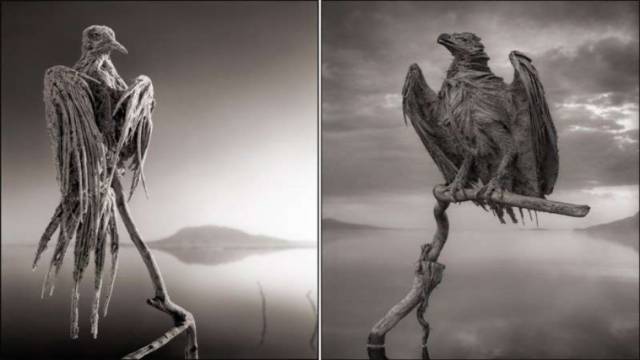Mystery lurks around Lake Natron, the lake that preys on bats, flamingos, and even buffaloes of enormous size. Petrified and dead, the animals look like statues guarding the lake.
The Truth Behind Tanzania’s Lake Natron, the Lake That Petrifies Animals
In 2011, photographer Nick Brandt traveled to the eastern region of Africa and took a detour to Lake Natron in Tanzania. What he thought was a perfect scenery for wildlife shots turned out to be a grave for animals. Brandt later found out that the famous lake turns them into stones.
Scroll down for the video

“When I saw those creatures for the first time alongside the lake, I was completely blown away,” says Brandt. “Instantly, I positioned them back to life, as if they were alive, and took some portraits.”
Across the Ravaged Lands is what came out of Nick Brandt’s trip, a collection of photographs that depict the life—or the lack thereof—of the animals that happen to have flown over and above the lake. As soon as the photos got out, news about the horrifying Lake Natron made the headlines of newspapers and televisions. Yet the mystery was never unraveled, making people more scared than they ever were.
Soon after, scientists and researches have emerged to explain the cause of the inexplicable phenomenon.

The lake is simply surrounded by extremely alkaline bedrock, just like the Dead Sea in Israel and the Great Salk Lake in Utah. As water evaporates from the Lake Natron, it leaves behind large concentrates of natron, a naturally occurring chemical mixture of sodium carbonate and baking soda. Because of its salinity, salt residues turn any inanimate objects, including dead animals, into rock-solid statues.
This is how Lake Natron petrifies animals. This, however, does not completely explain their deaths. The lake’s high salinity stills the water, creating a mirror-like illusion as if the surface were dry. Most times, birds fall for the trick that they end up crashing into the waters with a high pH level, which isn’t good for them. If that won’t kill them, the thriving endemic algae will.

Other than that, the temperature of the lake can go extremely hot or cold, depending on the season. Usually, the temperature is above 40° Celsius, which is too hot for animals.
The lake isn’t that mysterious, after all. But if you choose to go there, remember to be extra cautious.
